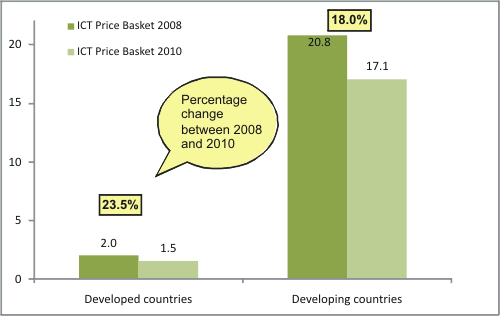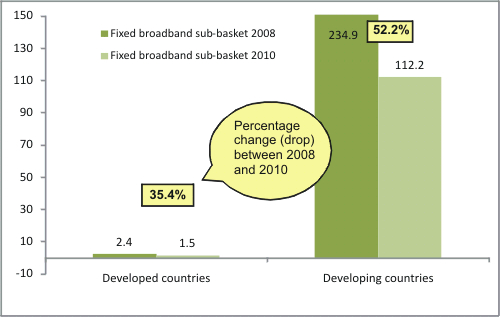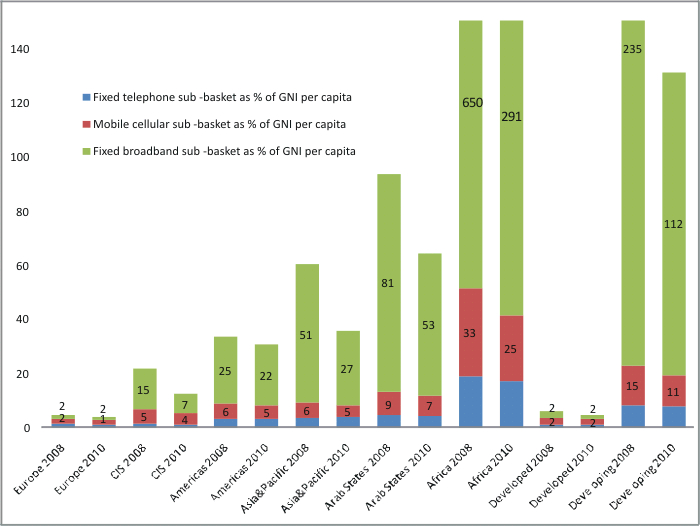Archived Newsroom • Press Release |
|
ICT services getting more affordable worldwide
Broadband prices drop by more than 50%; high-income economies of Europe and Asia-Pacific are most affordable markets; fast Internet still out of reach in developing world
Geneva, 16 May 2011 - Consumers and businesses globally are paying on average 18% less for entry-level information and communication technology (ICT) services than they were two years ago – and more than 50% less for high-speed Internet connections, according to new figures released today by ITU.
Data from ITU’s 2010 ICT Price Basket also show that relative prices for mobile cellular services decreased by almost 22% from 2008 to 2010, while fixed telephony costs declined by an average of 7% (see Table 1). Over the same period, the number of mobile cellular subscriptions worldwide grew from 4.0 to 5.3 billion.
“With ICTs now a primary driver of social and economic development, these results are highly encouraging,” said ITU Secretary-General Dr Hamadoun Touré. “Our next challenge is to find strategies to replicate the ‘mobile miracle’ for broadband, which is fast becoming basic infrastructure. Countries without affordable broadband access risk falling quickly behind.”
ITU’s ICT Price Basket (IPB) is a composite affordability measure based on three sub-baskets – fixed telephone, mobile cellular and fixed broadband Internet services – and computed as a percentage of average Gross National Income (GNI) per capita. As a comprehensive benchmarking tool, the IPB monitors the relative price of ICT services and provides an indication of how affordable services are, across countries, and over time.
Published annually, the latest IPB compares 2008 and 2010 tariffs at global and regional levels and highlights the difference in prices between developed and developing regions. Covering 165 economies, it is the only price basket to monitor the affordability of ICT services worldwide.
ICTs most affordable in the richest countries
This year’s IPB figures underline the fact that pricing remains a major factor in perpetuating the ‘digital divide’ between rich and poor. IPB results reveal a close link between the affordability of ICT services and national income levels: people in high-income countries pay relatively little for ICT services, while those in the world’s poorest countries pay relatively more.
All the economies at the top of the ICT Price Basket (indicating most affordable ICT services) have high GNI per capita, including many small economies, such as Monaco, Macao (China), Liechtenstein, Hong Kong (China) and Singapore. ICT prices correspond to less than 1% of GNI per capita in much of Europe and Asia and the Pacific’s high income economies, as well as in the US and Canada.
At the other end of the scale, the cost of ICT services averages 17% of GNI per capita in developing countries (see Chart 1).
Fixed broadband prices falling steeply
The overall fall in prices for fixed broadband services is mainly due to price decreases in developing countries, where the fixed broadband sub-basket dropped by 52%, compared to 35% in developed countries (see Chart 2). However, it should be noted that steep price drops often reflect the extremely high cost of broadband in developing countries. Even at half the price, the service is often still far beyond the pockets of average citizens.
The top countries with the relatively cheapest broadband prices are all high-income economies and include many of those ranked at the top of the IPB overall: Monaco, Macau (China), Liechtenstein, the US and Austria. Customers in 31 countries – all of them highly industrialized economies – pay only the equivalent of 1% or less of average monthly GNI per capita for an entry-level broadband connection.
In 32 countries, however, the monthly price of an entry-level fixed broadband subscription corresponds to more than half average monthly income. In 19 of those countries, a broadband connection costs more than 100% of monthly GNI per capita. And in a handful of developing countries the monthly price of a fast Internet connection is still more than ten times monthly average income.
Many of the countries where the cost of broadband Internet access is extremely high are UN-designated Least Developed Countries, but the group also includes Tajikistan, Swaziland, Uzbekistan, and Papua New Guinea.
Not surprisingly, both broadband penetration and Internet user levels in these countries remain extremely low.
Steepest price falls in Africa
Relative overall prices decreased by over 50% in Azerbaijan, Bhutan, Sri Lanka, Bangladesh, Venezuela, Guyana, Uganda and Austria (see Table 2). The top ten countries showing the greatest decrease in the ICT Price Basket value were countries with high values to begin with. Apart from Bangladesh, all are from Africa. While the drop is mainly due to price decreases in fixed broadband services, in several countries, including Azerbaijan, Bhutan, Benin, Kenya, Sri Lanka, Tanzania and Uganda, mobile tariffs also decreased considerably.
The regional price trends highlight that while ICT prices are falling in all regions of the world, the greatest price drops occurred in Africa, where fixed broadband prices fell by over 55% and mobile cellular prices by 25%.
Despite this encouraging trend, Africa continues to stand out for its relatively high prices. Fixed broadband Internet access in particular remains prohibitively high, and, across the region as a whole, still represented almost three times the monthly average per capita income. Only one out of ten people in Africa is using the Internet (see Chart 3).
| Table 1 |
 |
| Chart 1: ICT Price Basket by level of development, 2008 and 2010 |
 |
| Source: ITU |
| Chart 2: Fixed broadband sub-basket by level of development, 2008 and 2010 |
 |
| Source: ITU |
| Table 2: Ten economies with the greatest decrease in the ICT Price Basket, sorted by relative change (left) and value change (right) |
 |
| Source: ITU |
| Chart 3: ICT Price Basket by region and by level of development, 2008 and 2010 |
 |
| Source: ITU |
Within the UN system, ITU is the main source of internationally comparable data and statistics on ICT. The ICT Data and Statistics Division of the Telecommunication Development Bureau (BDT) collects, harmonizes and disseminates more than 100 telecommunication and ICT indicators from over 200 economies worldwide.
Data are accessible online through the ICT Eye portal (www.itu.int/ITU-D/icteye/Default.aspx), on CD and in print publications. The division regularly publishes analytical reports illustrating the latest trends in the sector. It monitors the development of the digital divide and has developed widely used benchmarking tools, such as the ICT Development Index (IDI). It also provides statistical training and capacity building to developing countries to improve internationally comparable data.
Selected charts and tables of the ICT Price Basket can be downloaded at:
http://www.itu.int/ITU-D/ict/ipb/
For more information, please contact:
Sarah Parkes,
Chief, Media Relations & Public Information
ITU
|
Susan Teltscher
Head, ICT Data & Statistics,
ITU,
|
About ITU...